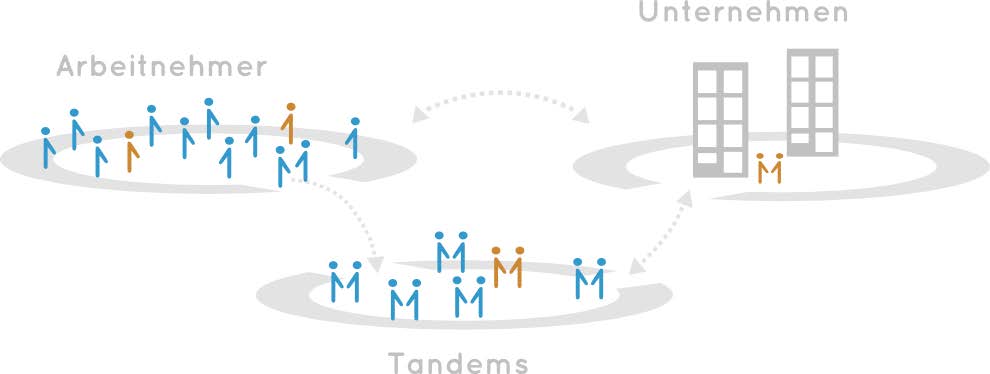The End of Talent Management

How can you attract, manage and retain talent in a modern organisation? Are the employers still the ones to decide, the ones in charge, the powerful puppeteers coordinating their talented staff top-Ââ€down? Or are the terms we are using already misleading us?
All those questions and many more were running through my mind when my co-Ââ€founder Anna and I started to develop Tandemploy in 2013. We were — and still are — sure that in order to create a life-Ââ€friendly economy we have to rethink our ideas of talent attraction, talent management and talent retention. And in many cases we have to start by rethinking the terms we are using. While ’talent attraction‘ is still a reasonably okay term, ’talent management‘ and ’talent retention‘ clearly belong to the ’old‘ working world where the employer is the one to decide – and impose ’top-Ââ€down‘ the direction of choice.
When we founded Tandemploy.com three years ago, our aim was to revolutionize the whole talent attraction process by helping people and companies to realize job-Ââ€sharing models. We were convinced that by offering this flexible working model, companies would be able to enlarge their target group — by no longer ignoring half of our society, i.e. all those who do not want to or simply cannot work in the classic (and totally inflexible) full-Ââ€time model: young parents, the elderly, people with chronic diseases, disabled people, freelancers, those doing time-Ââ€consuming voluntary work, students… The list is long.

It turned out that we were on to something. We launched a platform to connect people interested in job sharing with suitable ‘tandem’ partners and flexible companies, and the success stories very soon started to come in.
On Tandemploy.com, people can find suitable tandem partners to share a job with -†and meet companies that are open towards job sharing. After answering 22 short questions, users automatically receive suggestions for potential job sharing partners, based on a matching algorithm which -†besides some ’hard facts‘ -†mainly covers ’soft facts and skills‘ which are even more important in the context of close team work. While it is essential in some respects to have common goals and ideas, the algorithm also brings together users who are diverse and complementary in their competencies and strengths.
Even our earliest business customers received applications from candidates that they would have never received through conventional channels or typical full-Ââ€time job postings. The people registering on our platform and applying as ’super-Ââ€tandems‘ were highly qualified and proactive, the sort of talented people that take responsibility for their own lives, choices and happiness. They were — and still are — the kind of person every CEO wants to have on his or her team.
All you need to offer these individuals is time, flexibility and trust. The time for all the other aspects of their lives that they are passionate about. The flexibility to make work fit into their lives and not the other way around. And the trust that they will be able to organize their job-Ââ€sharing constellation themselves. With their tandem partner. And without being managed.
Once our platform was up and running and being used by more and more people and companies, we decided to go one step further. We wanted to not only make job seekers happier, but also create something for those already working in companies who are looking for more flexible work options. Empowering employees to find tandem partners within their organization and organize flexible working models at certain stages of their lives definitely appeared to be a win-Ââ€win-Ââ€concept for both individuals and companies.
Why not changing the way companies are ’managing‘ their talented employees by giving them the power to manage themselves? And why not give individuals maximum freedom and flexibility instead of always trying to find new ways to retain them or ’bond‘ with them? The best relationships in life, as we all know, are the ones where both partners allow each other the freedom they need. To tie somebody down might work for a short period, but it will never end in a sustainable or satisfying partnership.
In a business context, the main question must be: How can you motivate your employees to stay with you and your company, to spend a considerable part of their lives working towards your goals? Don’t your goals have to match theirs in order to achieve this kind of commitment? And shouldn’t the work conditions you are offering reflect their lives?
We remain convinced (and numerous facts & figures prove us right) that when you already have the talented employees you want, you simply have to give them the room to make work fit with their lives. You must offer them the space to announce their needs without fear and empower them to find solutions (within your company!) by themselves.
Some facts that show the benefits of job sharing:
— 87% of respondents said that the ability to job share meant the difference between staying with a company and leaving.
— 67% of the job sharers surveyed held team management and leadership roles.
— 71% of job sharers who tried to gain promotion were successful
— 30% enhanced productivity can be gained through two people job sharing
(The Job Share Project, 2011)
As a logical consequence from our first product (the job sharing platform open to everybody interested) we have started within the last year to develop a company-Ââ€internal solution – giving employees exactly the room they need to find flexible working solutions on their own. While our open platform is still focused on job sharing, our internal tool was designed to enable employees to organize all kinds of flexible working models within the company, such as job sharing, job rotation or projects. Whereas the public platform was developed to change the ‘talent attraction‘ game, our software as a service now helps companies to make their staff happier by giving them more trust, power and, most importantly, flexibility. Most notably, our software is used by the individuals themselves -†not by a manager or the HR department.
flex:workz offers employees of one company a closed cloud-Ââ€based room to organize flexible working models by themselves. The staff uses this internal and discrete community to connect with colleagues for job sharing, job rotation, projects or mentoring constellations.
The software can be used in any country worldwide, as it is easily translated and adapted to individual companies’ needs and corporate design. Organisations from Sweden to Australia have already announced their interest.
We believe that new times need new concepts. New words sometimes. And the courage to rethink and get over old concepts. As a leader of any kind of team you might like to consider these simple steps to give your employees the talent management they deserve:
- When interviewing a potential new hire, ask him/her about his/her perfect weekly working hours -†and try to realize exactly that!
- Empower your team members to experiment with different work styles and give them the freedom to implement those that work best for them
- If you have agreed to an employee only working 80%, don’t give him/her workloads that he/she can’t handle in the available time -†or propose to find a tandem partner instead!
- Start to say “goodbye” to the classic idea of managing your employees top-Ââ€down. Say “hello” to a bottom-Ââ€up approach and empower people to manage their tasks -Ââ€Â and ways of working -Ââ€Â on their own. After a while, they will approach you with solutions instead of problems.
The end of classic talent management has come.
This post is part of a talent project led by the Global Social Entrepreneurship Network (GSEN, founded by UnLtd) and supported by the BMW Foundation Herbert Quandt. The project aims to shed light on challenges and solutions related to the attraction, development, and retention of talent within entrepreneur support organizations.
Wait! Before you go…
Choose how you want the latest innovation content delivered to you:
- Daily — RSS Feed — Email — Twitter — Facebook — Linkedin Today
- Weekly — Email Newsletter — Free Magazine — Linkedin Group
 Jana Tepe and Anna Kaiser are job sharing CEOs of Tandemploy, a Berlin-based startup developing HR technology for job sharing and flexible working models. Coming from an HR background, Jana knew the challenge to find a job that really fits your life. Therefore, they design solutions which support people and companies to create a better future of work – TODAY.  Â
Jana Tepe and Anna Kaiser are job sharing CEOs of Tandemploy, a Berlin-based startup developing HR technology for job sharing and flexible working models. Coming from an HR background, Jana knew the challenge to find a job that really fits your life. Therefore, they design solutions which support people and companies to create a better future of work – TODAY.  Â
NEVER MISS ANOTHER NEWSLETTER!
LATEST BLOGS
Four ways you can ensure employees take accountability for their work
One of the most important driving factors for any successful business is a high-performing team. Having people working for you…
Read MoreWhat is digital upskilling and why is it important?
Photo by Annie Spratt on Unsplash In a world of business that never stands…
Read More


